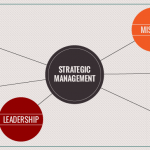Mission statements as strategic management tools – A brief history
smartKPIs.com Performance Architect update 25/2010
The pursuit of organizational clarity and alignment towards a strategic direction has preoccupied researchers and practitioners for many decades. Especially over the last 50 years, a variety of management concepts have been popularized and adopted by organizations with more or less success.
Two such management concepts that gained popularity since then are mission and vision statements. They are considered strategic management tools or instruments, one of the clearest definitions for both being: “The mission statement is a statement of a company’s purpose,…, if mission outlines what the company is attempting to achieve at the present time, its vision offers a view of what the enterprise might become.” (Grant 2002: 60).
The term “mission” is reported to have been used first by Jesuit monks, to depict the act of sending monks on overseas missions, such as the missions in the 16th century in South America, following the landing of Christopher Columbus (Merino and Newson 1995). Over time, the use of the term expanded from religion to the military, who used it to reflect a specific assignment allocated as part of a plan or strategy. The link between military and business vocabulary was facilitated by books such as “On War” by Carl von Clausewitz (1832), considered one of the most important treaties on the philosophy of war. An entire section of the book (“Of strategy in general”) was dedicated to strategy and is considered today an important precursor of strategy management literature.
One of the earliest uses of a mission statement outside of religious and military organizations is reported to have occurred in 1941, when the American Journal of Economics and Sociology was established by Adolph Lowe and Franz Oppenheimer. As founding members of the editorial board they adopted a mission statement for the journal that called for cooperation and constructive synthesis in social sciences (Forstater 2002).
In business context, the use of the term mission had a different path. As early as 1960, Stoller and Van Horn wrote about how the military approach to planning can be applied in a business context. Smalter (1964) published one of the first articles exploring the influence of military literature on management practice. It explored in detail how the military concept of missions can be applied in business, however the term was used more in a “program-package” sense and not in the sense it is widely used today. Tombach (1961:54) had a different approach to using the word “mission” to cross-over from military to business literature: “the mission of defense […] can be broadly defined as that of preventing or minimizing damage to a target or target complex […] from hostile action.”
According to David (1989), the link to the business environment was facilitated by Peter Drucker, who started to write on the topic in mid 1970s. One of Drucker’s recommended questions for any organization was: “What is our business?”. David (1989:90) considered the answer is reflected in Drucker’s own words (1973): “A business is not defined by its name, statutes, or articles of incorporation. It is defined by the business mission. Only a clear definition of the mission and purpose of the organization makes possible clear and realistic business objectives.”
McGinnis (1981), Pearce II (1982), Staples and Black (1984) were among the first to dedicate entire articles to the discussion of the use of missions statements as strategic management tools. The term “mission statement” was understood as expressing the fundamental purpose specific to an organisation.
By 1986, two things occurred. On one hand, mission statements became widely used in corporate environments. Want (1986:48) notes that: “Executives and consultants alike are familiar with mission statements, and many have participated in the mission-writing exercise.” On the other hand, divergent views how mission statements should be formulated and used started to emerge. Pearce II and David (1987) proposed eight key components, among which mentions of target customers and markets, identification of products and services, geographic domain, core technologies and desired public image. Want (1986) lists as primary components of corporate mission statements: purpose, principle business aims, corporate identity, policies of the company and the values.
Regardless of these challenges, by 1990s research on the use of mission statements started to focus on their use (Ireland and Hitt 1992), their role (Leuthesser and Kohli 1997) and impact on firm performance (Bart and Baetz 1998). From 2000 onwards, researchers focused increasingly on questioning the value added by mission statements. Titles such as “Mission Statements: Are They Smoke and Mirrors?” (Bartkus, Glassman and McAfee 2000) and “Mission Possible: Do School Mission Statements Work?” (Davis, Ruhe, Lee, Rajadhyaksha 2007) are illustrative. Further research in the impact of mission statements on the financial performance concluded that they have little or no impact on financial performance (Bartkus, Glassman and McAfee 2006).
One of the most comprehensive reviews of the topic by Stallworth Williams (2008) concluded that despite the challenges in the formulation and use of mission statements, they shouldn’t be considered fads, as they withstood the test of time and continue to matter.
Mission statements continue to remain an important strategic management and business performance management tool, helping with grounding organisations by clarifying their purpose or reason to exist and framing the context of their operations.
Stay smart! Enjoy smartKPIs.com!
Aurel Brudan
Performance Architect, www.smartKPIs.com
References
Bart C, Baetz M (1998) The relationship between mission statements and firm performance: An exploratory study, Journal of Management Studies, 35(6): 823-853.
Bartkus B, Glassman M and McAfee B (2000), Mission Statements: Are They Smoke and Mirrors? Business Horizons, November-December: 23-28.
Bartkus B, Glassman M and McAfee B (2006), Mission Statement Quality and Financial Performance, European Management Journal, 24(1): 86–94.
David F. (1989) How Companies Define Their Mission, Long Range Planning, 22(1): 90-97.
Davis JH, Ruhe JA, Lee M, Rajadhyaksha U (2007), Mission Possible: Do School Mission Statements Work?, Journal of Business Ethics, 70:99–110.
Forstater M (2002) How the AJES Got its Mission Statement in 1941, American Journal of Economics and Sociology, 61(4):779-786.
Grant RM (2002) Contemporary Strategy Analysis, 4th edition, Blackwell Publishers, Oxford, UK.
Ireland RD and Hitt MA (1992) Mission Statements: Importance, Challenge, and Recommendations for Development, Business Horizons, May-June: 34-42.
Leuthesser L and Kohli C (1997) Corporate Identity: The Role Of Mission Statements, Business Horizons, May-June: 34-42.
McGinnis VJ (1981), The mission statement: A key step in strategic planning, Business, November December: 39-43.
Merino O, Newson LA (1995) ‘Jesuit Missions in Spanish America: The Aftermath of the Expulsion’. Paper presented at the Conference of Latin Americanist Geographers, accessed at http://sites.maxwell.syr.edu/CLAG/yearbook1995/newson.pdf on 29 June 2010.
Pearce II JA (1982), The Company Mission as a Strategic Goal, Sloan Management Review, Spring: 15-24.
Pearce II JA, David F (1987) Corporate Mission Statements: The Bottom Line, The Academy of Management Executive, 1(2):109- 115.
Smalter DJ (1964) The Influence of Department of Defense Practices on Corporate Planning, Management Technology, 4(2):115-138.
Stallworth Williams L (2008), The Mission Statement – A Corporate Reporting Tool With a Past, Present, Future, Journal of Business Communication, 45( 2): 94-119.
Staples WA, Black KU (1984) Defining Your Business Mission: A Strategic Perspective, Journal of Business Strategies, 1:33-39.
Stoller DS, Van Horn RL (1960) Design of a Management Information System, Management Technology, 1(1):86-91.
Tombach H (1961) Critique of Air Defense Measures of Effectiveness, Management Technology, 1(3):52-62.
Von Clausenwitz C (1832) On War, 1st edition in English (1874) translated by Colonel J.J. Graham, accessed at http://www.gutenberg.org/etext/1946 on 28 June 2010.
Want JH (1986) Corporate mission, Management Review, August: 46–50.
Walker, Rob 1992,“Rank Xerox – Management Revolution”, Long Range Planning, Vol. 25, No. 1, pp. 9 to 21

Tags: Mission Statements, Performance Architect Update, Strategic Management, Tools





